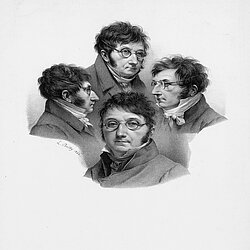Loading the page ...
Louis-Léopold Boilly
1761 La Bassée – 1845 Paris
Louis-Léopold Boilly, who distinguished himself as a painter, draughtsman and lithographer, received his first instruction in drawing from his father. In 1775 he went to the northern French towns of Douai and Arras where he earned his living with small-format portraits. In 1785 the artist settled in Paris, where he again began to work as a portraitist and author of genre depictions of amorous escapades. With time, however, Boilly developed an independent and novel version of the genre scene, becoming a humorous and observant chronicler of his times, who followed the everyday life of the French metropolis with an alert and increasingly critical eye. Boilly has therefore rightly been dubbed the “Little Master of the Revolution”. Although he had initially confined his painting to small formats, he gradually turned in the course of his artistic development to monumental, complex depictions of social mores. People from all walks of life come together in all sorts of subtly observed situations, thus evoking – like Balzac’s Comédie humaine – a colourful, kaleidoscopic, yet true-to-life picture of French society in the first half of the 19th century. Boilly was also a pioneer in the field of lithography in France, having recognized at an early stage the potential this medium offered to publishing. He produced an extensive printed oeuvre distinguished by the brilliance of draughtmanship and considerable technical refinement.
On Offer

Archive

